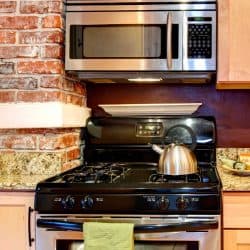The placement of your appliances might not seem like a big deal. More specifically, it might not seem like a big deal to place a microwave anywhere you want. But, there are instances where it might not be the best fit. Placing it near a stove might cause growing concerns. If you're wondering if your microwave is too close to the stove, we've found out.
To determine if the microwave is too close, you will first have to consider the type of microwave. Countertop microwaves need to be far away enough to avoid the heat from a stovetop. On the other hand, over-the-range microwaves need enough clearance for proper ventilation. If you notice food splatter or heat damage on your countertop microwave, it's too close to the stove. Additionally, any damage to the base of the over-the-range microwave indicates it needs to be farther away.
Now that we know how to tell if the microwave is too close to the stove, you might have more to ask. What's the appropriate distance between the two appliances? Are there areas where you should not place a microwave? If you'd like to take a deeper look, keep reading ahead.

How Far Away Should a Microwave Be From the Stove?
Countertop Microwaves
Countertop microwaves should be at least two feet away from the stove. They can't withstand the heat from the stove like an over-the-stove variation. Giving them at least two feet of distance can ensure hot food spills won't damage the exterior of the microwave. Additionally, this prevents them from overheating because of the additional heat from the stove.
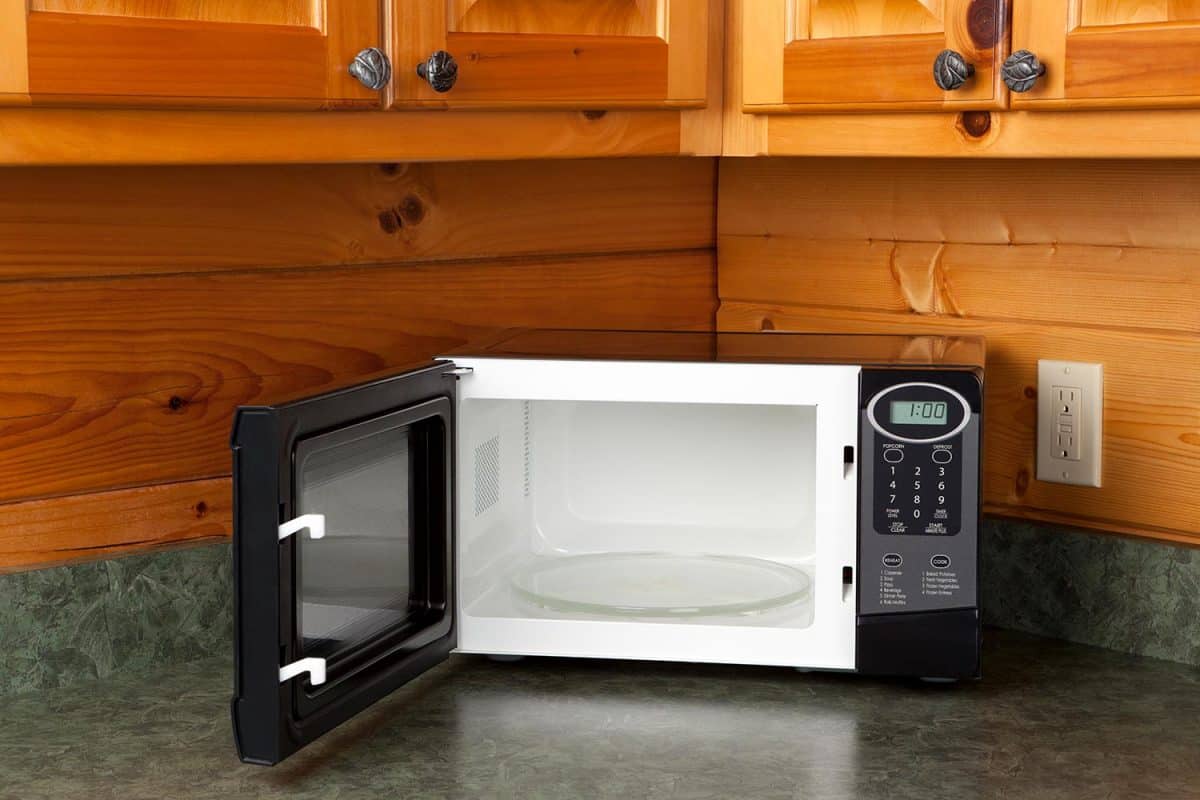
Over-the-Stove Microwaves
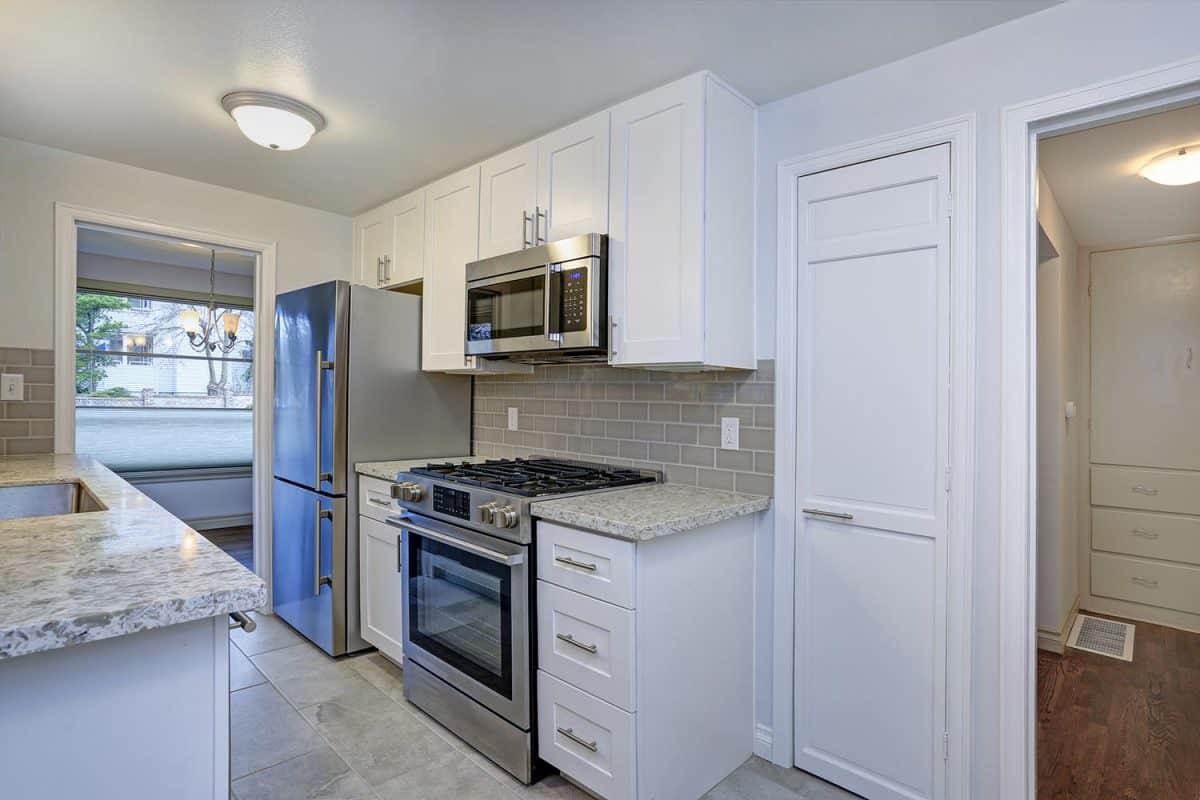
Over-the-stove microwaves are a different story. The clearance for this type of microwave depends on manufacturer instructions. They're made to withstand the flames up to a certain point. In other words, they can tolerate less area of clearance. Though, that does not mean it can't be too close to the stovetop.
Some manufacturers like General Electric allow 13 to 16 inches of clearance between the stove and the microwave. However, the general recommendation of clearance is at least 18-inches between the stove and microwave.
We cover this more in detail in another post. If you'd like to find out more, check out our post here.
Where Do You Put a Microwave in a Tiny Kitchen?
Now that we know how far to distance a countertop microwave from the stove, you might be considering your options. Maybe you don't want to place it near the stove anymore. There's only so much space you can have. So, where can we put a microwave in a tiny kitchen?
The goal is to maintain as much space as possible. So, depending on your kitchen layout, there will be various options you can choose from. Let's go over some ideas!
Corner of the Counter
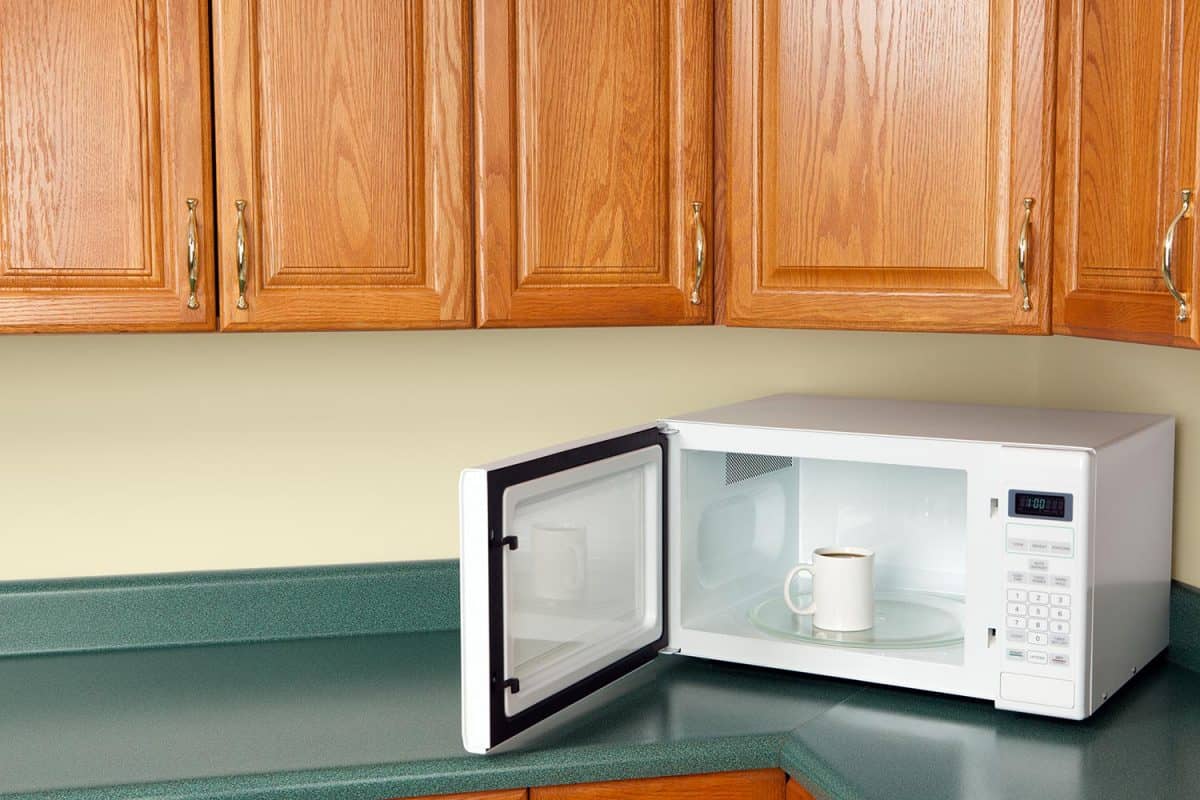
The corner of the counter is a good spot for a countertop microwave. It's usually unused because it's one of the farthest parts of the counter. Since a microwave takes quite a bit of space, it will utilize the corner well.
Above the Oven

If you have a modern kitchen, the chances are that you will have a pillar of appliances. To save space, you can place the microwave above the single or double oven on the pillar.
Cabinet
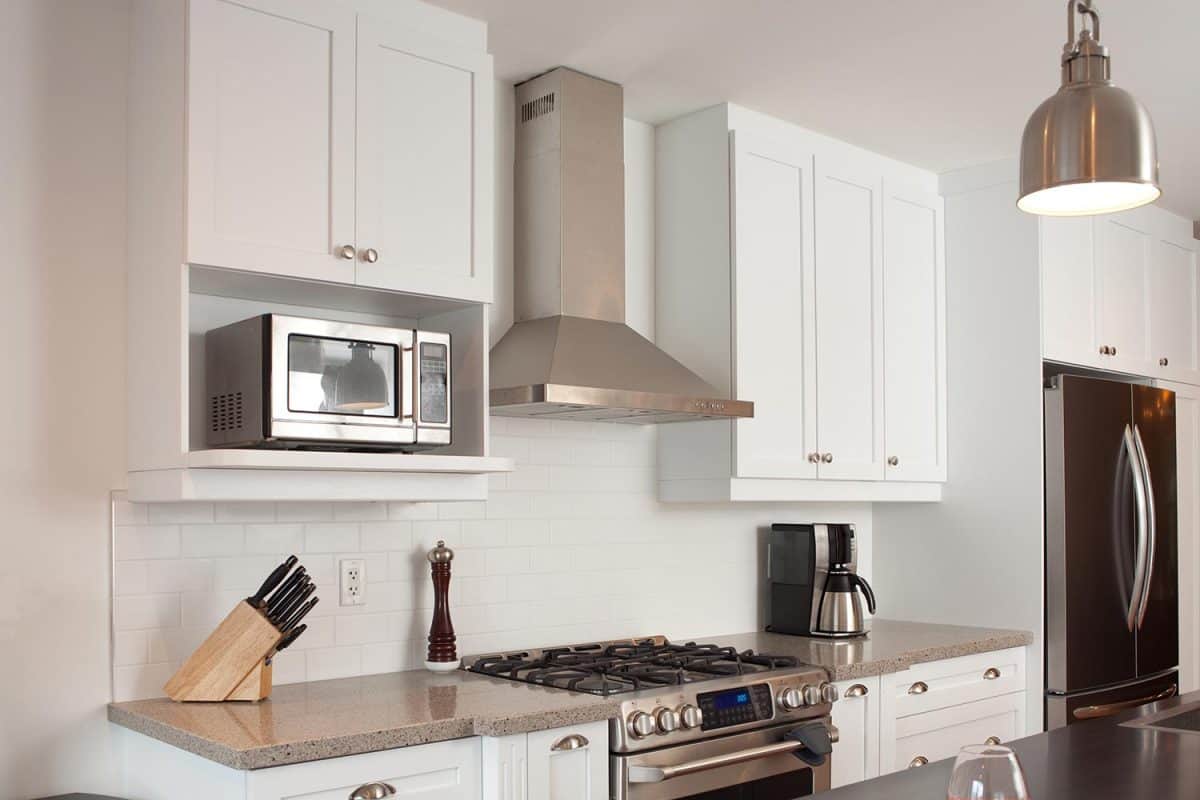
To find space, we can get a little creative. In general, there are a bunch of cabinets in a kitchen. If you have a cabinet with enough space, you can tuck the microwave inside. This method will keep the appliance neatly tucked away. Though, there are better options than placing it in your cabinet.
Mounting
Suspended Shelves
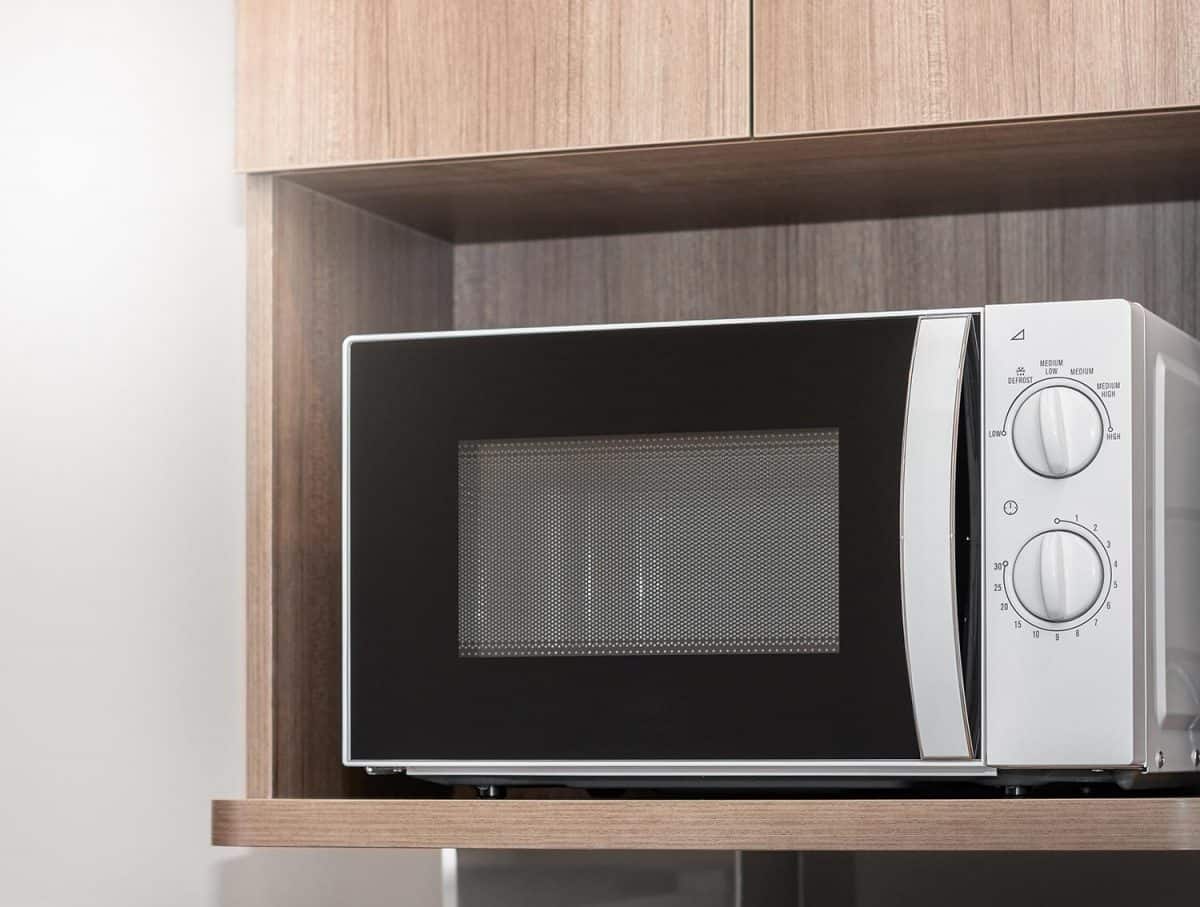
Some of these options won't apply to others. So, there might be some hands-on work we can do to mount the microwave in different spots. For example, if there's no room in your cabinets, you can opt to do custom shelving.
Kitchens with high cabinets might provide enough space to install a lower shelf. Of course, you'd have to measure the dimensions of your microwave first. Then, use your measurements to accommodate the size of the microwave. If you go with this option, there should be ample room between the shelves and the countertop.
Wall Bracket
Click here to see these wall brackets on Amazon.
Of course, installing shelves on cabinets can also give your kitchen a stuffy look. This is especially true if your kitchen cabinets already take up room between them and the countertop. For this reason, you can opt to use free wall space.
You can install wall brackets or a hanging shelf to hold your microwave. To get the best results, you should check the microwave specifications to check for the weight. With this information, purchase brackets that can withstand the microwave.
Where Should You Not Put a Microwave?
Since we have ideas flowing in some areas, it would also be helpful to keep in mind where not to put a microwave. Placement is crucial to how accident-prone the microwave can be. For example, if you place a microwave too high, shorter people are at risk of spilling hot foods. This situation can cause damage to appliances as well as bodily harm.
For this reason, avoid placing the microwave in spots that are too far to reach. Another area that you should be cautious about is a cabinet. We mentioned above that a cabinet is a space to keep the microwave away in a tidy spot. However, the exception is if it can provide enough space to accommodate one.
The Dangers
The first reason is that a microwave needs enough support. While cabinets accomplish this, it does so at the cost of airflow. As some suggest, countertop microwaves have vents in the back. They use it to exhaust steam. With a lack of airflow, you're more at risk of overheating the microwave and causing a fire hazard.
Does a Microwave Above the Stove Need To Be Vented?
To install an above-the-stove microwave, you would need to exclude a range hood. Range hoods improve the air quality in your kitchen. Without one, you may be violating building codes.
In the absence of a range hood, you will need to need to consider your venting options. As some suggest, you have the choice of external and recirculating ventilation.
Ventilation
External ventilation requires the most effort to install. You will have to connect a series of ducts from the area above the microwave to the outside. If you want the most efficient way to improve air quality, this is the way to go.
The other option you have is recirculating ventilation. With this option, the air is sucked into the microwave's filter and recirculated back. Recirculating ventilation isn't the best option if you want to prioritize good air quality.
How Do You Vent a Whirlpool Microwave?
If you own a Whirlpool microwave, you have two options for ventilation. You can skip installing ductwork above the microwave. It can recirculate air back into the kitchen.
However, if you want to vent it, some recommend consulting the user manual for instructions. It should guide you on modifying the top of the microwave to allow ventilation to go through your exhaust vent.
Can Stove and Microwave Be on the Same Circuit?
In general, microwaves need their own dedicated circuit. If you check the user manual of your microwave, it will likely call for a dedicated 20 amp circuit. You might think it's not a necessity. After all, you might not use the microwave all the time. So, there's no problem sharing a circuit between a stove and microwave, right?
It might work a couple of times. But, if you plan to use various appliances at the same time, the circuit will trip. As others recommend, if the instructions say your microwave needs a dedicated circuit, you won't be able to share one with the stove.
Final Takeaway
Microwave placement might not seem like a big deal. But, it does matter! With a few ideas, you can save space and organize the kitchen to suit your needs! We hope you found the information above insightful!
Before you go, do you have other microwave concerns? Are you wondering if a toaster oven can replace a microwave? To find out more, check out our post here. Until next time!


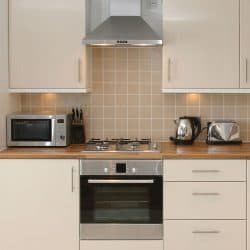
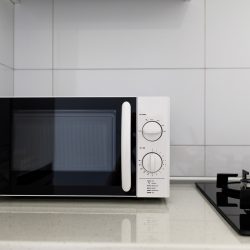
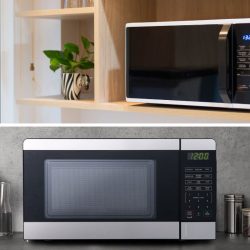

![A small modern kitchen with oak cabinetries, white floating cabinets, and a microwave on top of the countertop, How Big is a Microwave? [By Type]](https://kitchenseer.com/wp-content/uploads/2021/08/A-small-modern-kitchen-with-small-oak-cabinets-white-floating-cabinets-and-a-microwave-on-top-of-the-cooktop-250x250.jpg)
